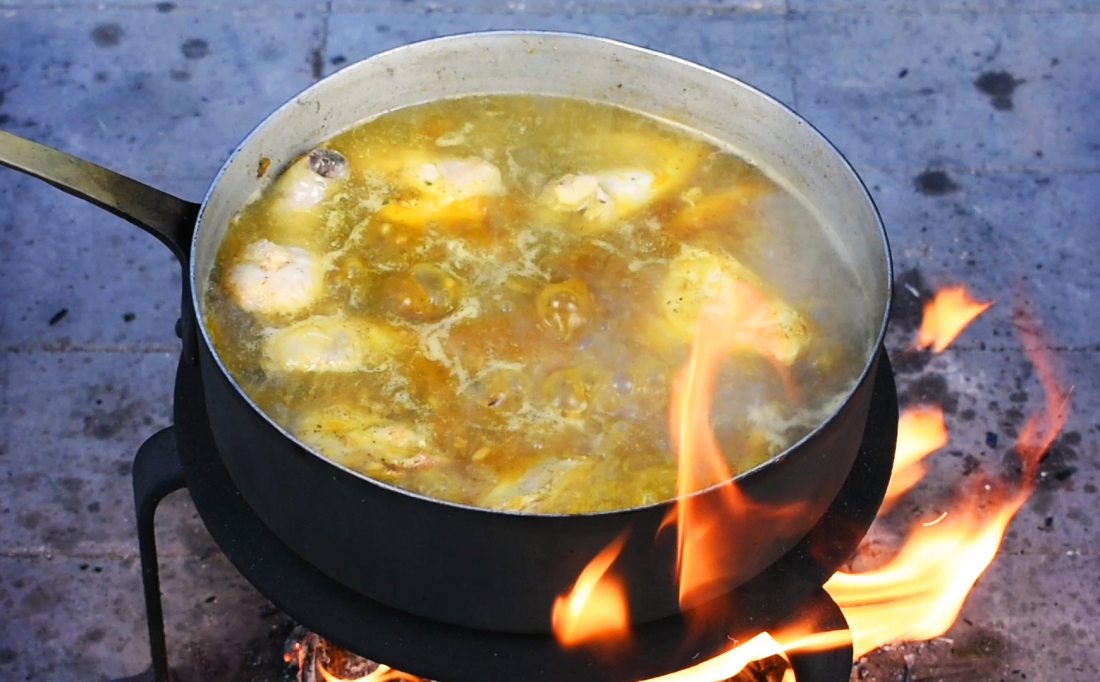Cinnamon, ginger, and pepper are the spices that Aldebrandin of Siena (13th century) suggests for eggs cooked with meat, in order to make them more nutritious and remove the possible harm. The same author considers saffron with chicken broth particularly healthy for the stomach, whereas we find the suggestion to cook just a little the eggs to make them easier to digest in De Flore Dietarum, an 11th-century medical handbook. As in the case of the turnip soup we prepared recently, here medicine and high-end cuisine meet to create a dish not only tasty, but also healthy according to the medical advice of the late Middle Ages.
Chicken is the most common meat in the medieval cookbooks. Considered healthy by the physicians, it was prepared in many ways. For example, we used it to prepare a blancmange, a pie, and a stew with a fennel-flower based sauce. We selected this recipe from an anonymous Tuscan manuscript, conventionally called Anonimo Toscano (14th century). Though it is mainly a vernacular translation of the Liber de Coquina (written at the end of the 13th century), there are many changes and additions. For example, this recipe is a variation of one from the Liber de Coquina, but with more spices: the Latin manuscript calls just for saffron.
The anonymous author frequently mentions for whom the recipe is meant, for example the master, the familia (the servants), or, as in this case, the cook himself: the recipe ends with the imperative mangia (eat), quite frequent in this cookbook. When the plate is intended for the master, he writes instead da’ (a) mangiare (serve) or uses different verbs.
Below, you will find the original text with our English translation, a note about the ingredients, and the video of the recipe, with English and Italian subtitles. Enjoy!
Ingredients
1 chicken
cured pork fatback
1 egg
1 onion
spices (saffron, black pepper, cloves, cinnamon, fresh ginger)
fresh herbs (rosemary and marjoram)
Method
Cut the chicken into pieces, mince the cured pork fatback, and slice the onion.
Melt the cured pork fatback and fry the onion until it wilts, then add the chicken. Sear the meat for a few minutes, then add water and cook for about one hour.
Grind in the mortar black pepper, cinnamon, and cloves, then add the saffron. Mince finely the herbs and ginger, then pound them in the mortar with the spices. Dilute the mixture with a little quantity of chicken broth. When the chicken is almost cooked through, add the spices to the broth.
Beat the egg diluting with cool water and chicken broth, then add it to the soup and stir. As soon as it starts to boil, remove from the fire and serve.
Note about the ingredients
Saffron was one of the most important spices since the late Middle Ages. As well as pepper, it appears in a great number of recipes. It was cultivated in Italy since the Antiquity, but the production was insufficient to meet the demand, so it was also imported as attested by many authors, for example Aldebrandin of Siena who mentions the local and the oriental varieties. In the cookbooks, we find two words for saffron, and in a few recipes they are present both: the Latin term crocus and zafferano/saffrano from Arabic, probably to distinguish between the local and the imported kinds.
In this case, it is important to add a good amount of saffron to prevent the green of the herbs from overshadowing the yellow, fundamental for a better outcome of the recipe. The author does not write which herbs we have to use. We chose from our aromatic garden two herbs used in this cookbook, but you can use the ones you have at disposal, for example, mint, dill, cilantro, thyme, or sage.
The cooking time changes depending on the size and breed of the chicken.
Diluting the eggs with cool water before adding the broth is an essential step to prevent it from thickening too soon. The aim of the author is obtaining a brodo granato: a broth with small and homogeneous grains of eggs. Pay attention not to overcook the egg.
Original text
Togli polli smembrati, e metti a friggere con cipolle, e lardo et acqua abbastanza; e quando siranno quasi cotti, togli erbe odorifere, tritale bene col zaffarano, pepe, garofani, cennamo e zenzovo, e distempera col brodo predetto, e mesta onni cosa insieme; poi tolli ova dibattute, e mettivi un poco d’acqua fredda, e aggiungivi di quel brodo, e mesta, e poni a fuoco. Et quando cominciarà a bullire, levala dal fuoco, e mangia.
Translation
Take chickens cut into pieces and fry with onions, lardo, and enough water. When they will be almost cooked through, take aromatic herbs, pound them well with saffron, pepper, cloves, cinnamon, and ginger, and dilute with the aforementioned broth, mixing all the ingredients together. Then, take beaten eggs and dilute with cool water, adding the broth; mix and cook it. When the broth starts to boil, remove from the fire and eat.
Recipes
Medieval Turnip Soup VIDEO
Medieval Beans and Bacon VIDEO
Medieval Prawn Pie VIDEO
Medieval Foxtail Millet Polenta and Spit-Roasted Goose VIDEO
Medieval Blancmange VIDEO
Medieval Peasant’s Beef Stew VIDEO
Medieval Peasant’s Leek Soup VIDEO
Medieval Quail Stew with Coconut VIDEO
Medieval Chicken Pie VIDEO
Medieval Green Ravioli VIDEO
Medieval Walnut Bread VIDEO
Medieval Lasagna VIDEO
Medieval Lamb Stew VIDEO
Medieval Quails with Sumac VIDEO
Medieval Sweet and Sour Sardines VIDEO
Medieval Trouts with Green Sauce VIDEO
Medieval Clams VIDEO
Medieval Sea Bream VIDEO
Medieval Roast Lamb with Green Sauce VIDEO
Medieval Chicken with Fennel Flowers VIDEO
Medieval Fried Fish VIDEO
Medieval Tripe VIDEO
Medieval Red Mullet Soup VIDEO
Medieval Roast Beef with Arugula Seed Sauce VIDEO


